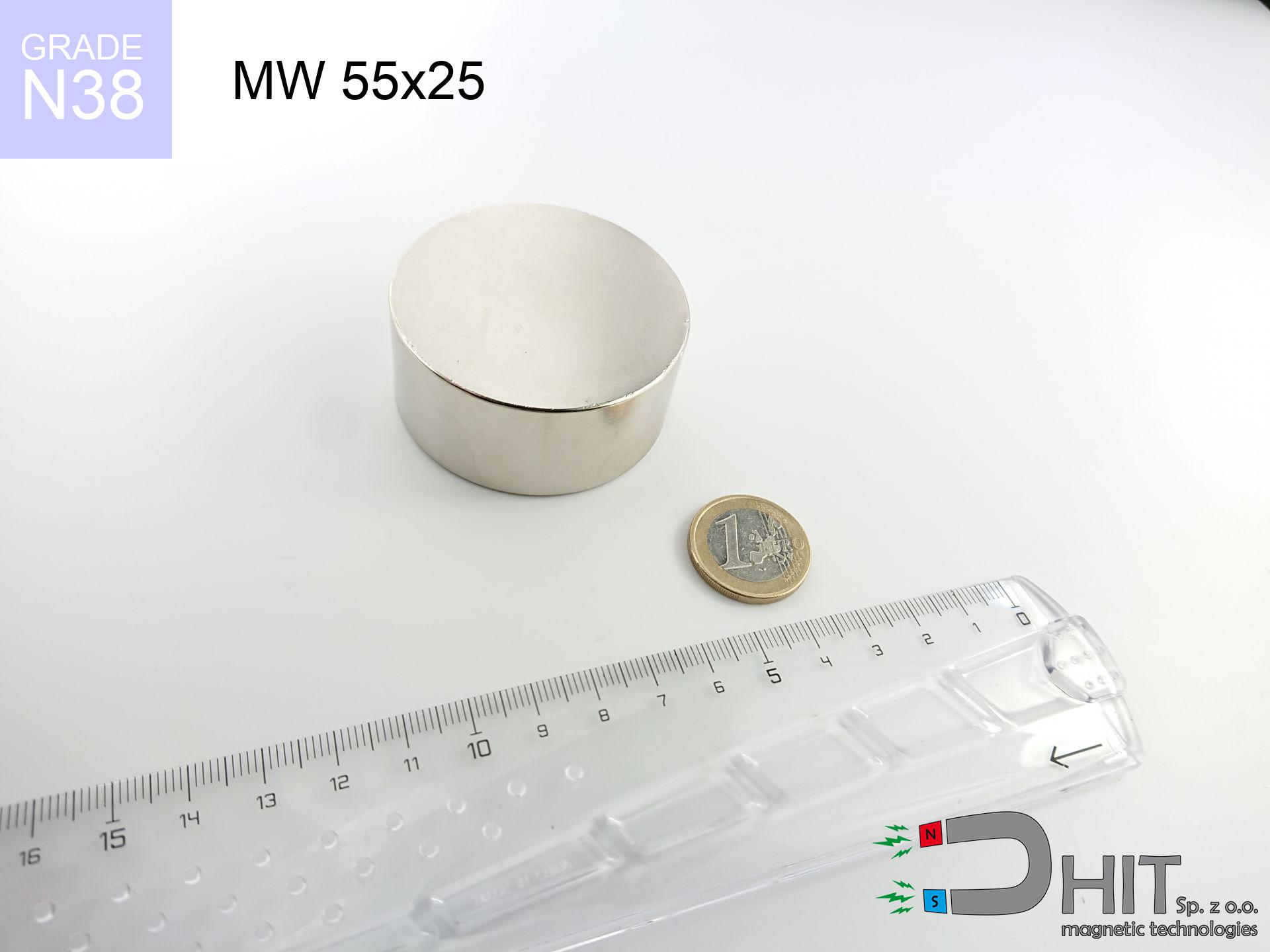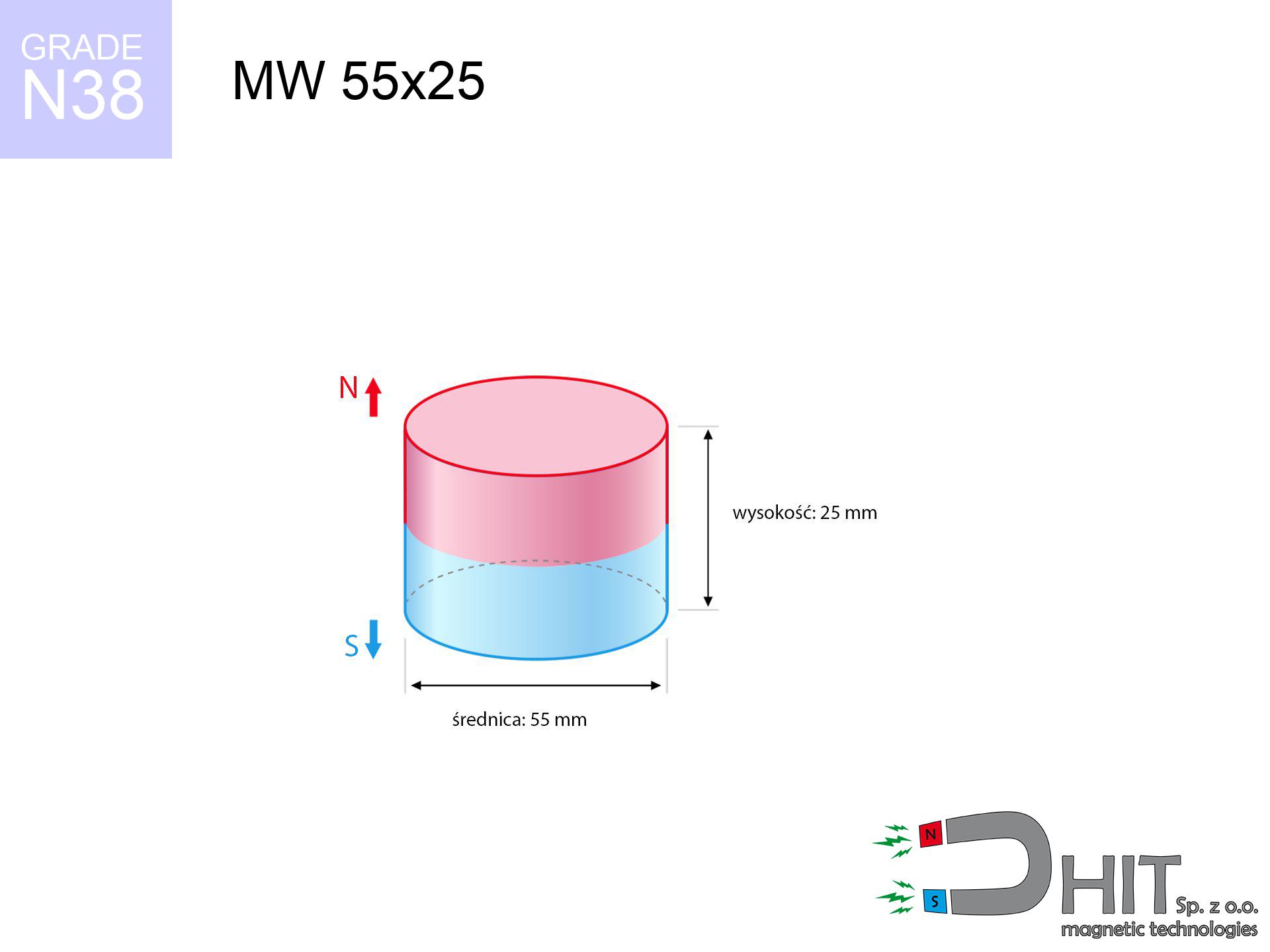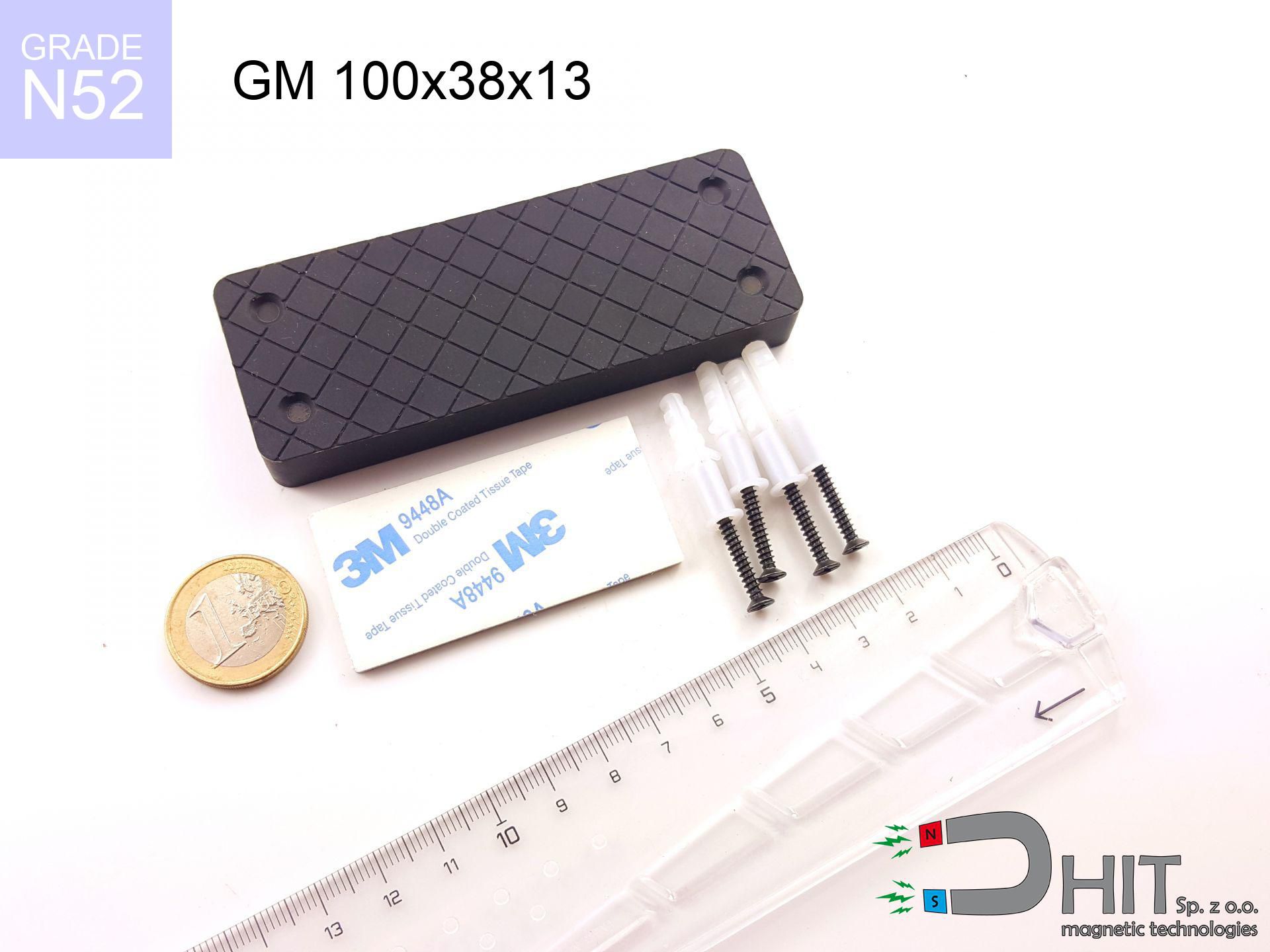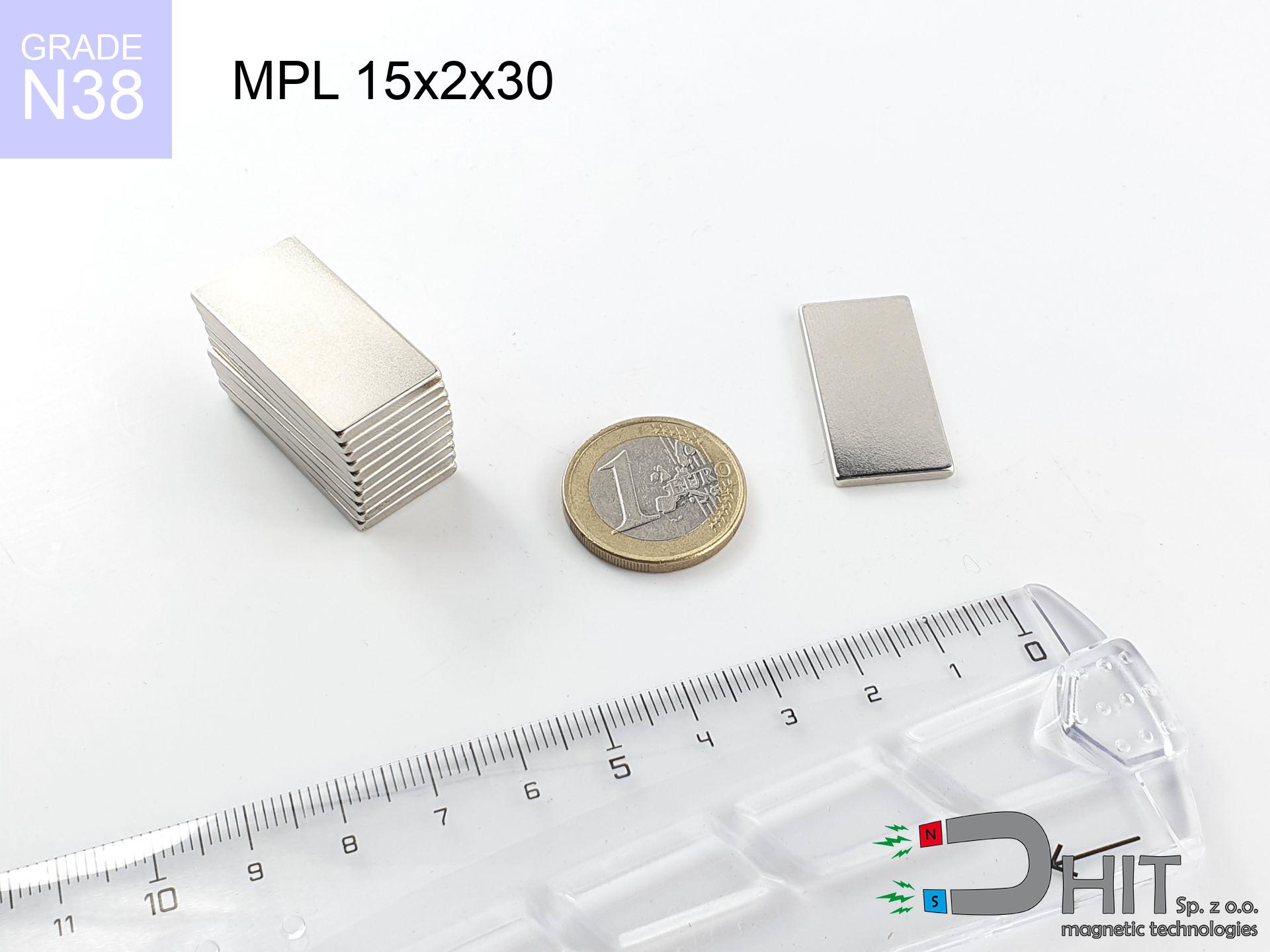MW 55x25 / N38 - cylindrical magnet
cylindrical magnet
Catalog no 010081
GTIN: 5906301810803
Diameter Ø
55 mm [±0,1 mm]
Height
25 mm [±0,1 mm]
Weight
445.47 g
Magnetization Direction
↑ axial
Load capacity
92.25 kg / 904.94 N
Magnetic Induction
416.97 mT / 4170 Gs
Coating
[NiCuNi] Nickel
154.21 ZŁ with VAT / pcs + price for transport
125.37 ZŁ net + 23% VAT / pcs
bulk discounts:
Need more?Do you have questions?
Call us now
+48 22 499 98 98
otherwise contact us using
request form
our website.
Lifting power along with appearance of a magnet can be tested with our
online calculation tool.
Order by 14:00 and we’ll ship today!
MW 55x25 / N38 - cylindrical magnet
Specification / characteristics MW 55x25 / N38 - cylindrical magnet
| properties | values |
|---|---|
| Cat. no. | 010081 |
| GTIN | 5906301810803 |
| Production/Distribution | Dhit sp. z o.o. |
| Country of origin | Poland / China / Germany |
| Customs code | 85059029 |
| Diameter Ø | 55 mm [±0,1 mm] |
| Height | 25 mm [±0,1 mm] |
| Weight | 445.47 g |
| Magnetization Direction | ↑ axial |
| Load capacity ~ ? | 92.25 kg / 904.94 N |
| Magnetic Induction ~ ? | 416.97 mT / 4170 Gs |
| Coating | [NiCuNi] Nickel |
| Manufacturing Tolerance | ±0.1 mm |
Magnetic properties of material N38
| properties | values | units |
|---|---|---|
| remenance Br [Min. - Max.] ? | 12.2-12.6 | kGs |
| remenance Br [Min. - Max.] ? | 1220-1260 | T |
| coercivity bHc ? | 10.8-11.5 | kOe |
| coercivity bHc ? | 860-915 | kA/m |
| actual internal force iHc | ≥ 12 | kOe |
| actual internal force iHc | ≥ 955 | kA/m |
| energy density [Min. - Max.] ? | 36-38 | BH max MGOe |
| energy density [Min. - Max.] ? | 287-303 | BH max KJ/m |
| max. temperature ? | ≤ 80 | °C |
Physical properties of sintered neodymium magnets Nd2Fe14B at 20°C
| properties | values | units |
|---|---|---|
| Vickers hardness | ≥550 | Hv |
| Density | ≥7.4 | g/cm3 |
| Curie Temperature TC | 312 - 380 | °C |
| Curie Temperature TF | 593 - 716 | °F |
| Specific resistance | 150 | μΩ⋅Cm |
| Bending strength | 250 | Mpa |
| Compressive strength | 1000~1100 | Mpa |
| Thermal expansion parallel (∥) to orientation (M) | (3-4) x 106 | °C-1 |
| Thermal expansion perpendicular (⊥) to orientation (M) | -(1-3) x 10-6 | °C-1 |
| Young's modulus | 1.7 x 104 | kg/mm² |
Physical modeling of the magnet - report
Presented data represent the result of a mathematical analysis. Results are based on models for the class NdFeB. Operational conditions might slightly differ from theoretical values. Use these data as a preliminary roadmap during assembly planning.
MW 55x25 / N38
| Distance (mm) | Induction (Gauss) / mT | Pull Force (kg) | Risk Status |
|---|---|---|---|
| 0 mm |
4169 Gs
416.9 mT
|
92.25 kg / 92250.0 g
905.0 N
|
dangerous! |
| 1 mm |
4034 Gs
403.4 mT
|
86.37 kg / 86369.8 g
847.3 N
|
dangerous! |
| 2 mm |
3894 Gs
389.4 mT
|
80.47 kg / 80469.7 g
789.4 N
|
dangerous! |
| 3 mm |
3751 Gs
375.1 mT
|
74.67 kg / 74670.6 g
732.5 N
|
dangerous! |
| 5 mm |
3461 Gs
346.1 mT
|
63.58 kg / 63580.6 g
623.7 N
|
dangerous! |
| 10 mm |
2756 Gs
275.6 mT
|
40.32 kg / 40320.8 g
395.5 N
|
dangerous! |
| 15 mm |
2140 Gs
214.0 mT
|
24.31 kg / 24308.3 g
238.5 N
|
dangerous! |
| 20 mm |
1644 Gs
164.4 mT
|
14.34 kg / 14338.1 g
140.7 N
|
dangerous! |
| 30 mm |
975 Gs
97.5 mT
|
5.05 kg / 5046.0 g
49.5 N
|
warning |
| 50 mm |
388 Gs
38.8 mT
|
0.80 kg / 801.0 g
7.9 N
|
safe |
MW 55x25 / N38
| Distance (mm) | Friction coefficient | Pull Force (kg) |
|---|---|---|
| 0 mm | Stal (~0.2) |
18.45 kg / 18450.0 g
181.0 N
|
| 1 mm | Stal (~0.2) |
17.27 kg / 17274.0 g
169.5 N
|
| 2 mm | Stal (~0.2) |
16.09 kg / 16094.0 g
157.9 N
|
| 3 mm | Stal (~0.2) |
14.93 kg / 14934.0 g
146.5 N
|
| 5 mm | Stal (~0.2) |
12.72 kg / 12716.0 g
124.7 N
|
| 10 mm | Stal (~0.2) |
8.06 kg / 8064.0 g
79.1 N
|
| 15 mm | Stal (~0.2) |
4.86 kg / 4862.0 g
47.7 N
|
| 20 mm | Stal (~0.2) |
2.87 kg / 2868.0 g
28.1 N
|
| 30 mm | Stal (~0.2) |
1.01 kg / 1010.0 g
9.9 N
|
| 50 mm | Stal (~0.2) |
0.16 kg / 160.0 g
1.6 N
|
MW 55x25 / N38
| Surface type | Friction coefficient / % Mocy | Max load (kg) |
|---|---|---|
| Raw steel |
µ = 0.3
30% Nominalnej Siły
|
27.68 kg / 27675.0 g
271.5 N
|
| Painted steel (standard) |
µ = 0.2
20% Nominalnej Siły
|
18.45 kg / 18450.0 g
181.0 N
|
| Oily/slippery steel |
µ = 0.1
10% Nominalnej Siły
|
9.23 kg / 9225.0 g
90.5 N
|
| Magnet with anti-slip rubber |
µ = 0.5
50% Nominalnej Siły
|
46.13 kg / 46125.0 g
452.5 N
|
MW 55x25 / N38
| Steel thickness (mm) | % power | Real pull force (kg) |
|---|---|---|
| 0.5 mm |
|
3.08 kg / 3075.0 g
30.2 N
|
| 1 mm |
|
7.69 kg / 7687.5 g
75.4 N
|
| 2 mm |
|
15.37 kg / 15375.0 g
150.8 N
|
| 5 mm |
|
38.44 kg / 38437.5 g
377.1 N
|
| 10 mm |
|
76.88 kg / 76875.0 g
754.1 N
|
MW 55x25 / N38
| Ambient temp. (°C) | Power loss | Remaining pull | Status |
|---|---|---|---|
| 20 °C | 0.0% |
92.25 kg / 92250.0 g
905.0 N
|
OK |
| 40 °C | -2.2% |
90.22 kg / 90220.5 g
885.1 N
|
OK |
| 60 °C | -4.4% |
88.19 kg / 88191.0 g
865.2 N
|
|
| 80 °C | -6.6% |
86.16 kg / 86161.5 g
845.2 N
|
|
| 100 °C | -28.8% |
65.68 kg / 65682.0 g
644.3 N
|
MW 55x25 / N38
| Gap (mm) | Attraction (kg) (N-S) | Repulsion (kg) (N-N) |
|---|---|---|
| 0 mm |
254.60 kg / 254602 g
2497.6 N
5 431 Gs
|
N/A |
| 1 mm |
246.57 kg / 246567 g
2418.8 N
8 206 Gs
|
221.91 kg / 221911 g
2176.9 N
~0 Gs
|
| 2 mm |
238.37 kg / 238373 g
2338.4 N
8 068 Gs
|
214.54 kg / 214536 g
2104.6 N
~0 Gs
|
| 3 mm |
230.21 kg / 230207 g
2258.3 N
7 929 Gs
|
207.19 kg / 207186 g
2032.5 N
~0 Gs
|
| 5 mm |
214.04 kg / 214042 g
2099.8 N
7 645 Gs
|
192.64 kg / 192638 g
1889.8 N
~0 Gs
|
| 10 mm |
175.48 kg / 175477 g
1721.4 N
6 923 Gs
|
157.93 kg / 157929 g
1549.3 N
~0 Gs
|
| 20 mm |
111.28 kg / 111282 g
1091.7 N
5 513 Gs
|
100.15 kg / 100154 g
982.5 N
~0 Gs
|
| 50 mm |
23.33 kg / 23326 g
228.8 N
2 524 Gs
|
20.99 kg / 20994 g
205.9 N
~0 Gs
|
MW 55x25 / N38
| Object / Device | Limit (Gauss) / mT | Safe distance |
|---|---|---|
| Pacemaker | 5 Gs (0.5 mT) | 27.5 cm |
| Hearing aid | 10 Gs (1.0 mT) | 21.5 cm |
| Mechanical watch | 20 Gs (2.0 mT) | 17.0 cm |
| Mobile device | 40 Gs (4.0 mT) | 13.0 cm |
| Car key | 50 Gs (5.0 mT) | 12.0 cm |
| Payment card | 400 Gs (40.0 mT) | 5.0 cm |
| HDD hard drive | 600 Gs (60.0 mT) | 4.5 cm |
MW 55x25 / N38
| Start from (mm) | Speed (km/h) | Energy (J) | Predicted outcome |
|---|---|---|---|
| 10 mm |
18.05 km/h
(5.01 m/s)
|
5.60 J | |
| 30 mm |
25.98 km/h
(7.22 m/s)
|
11.60 J | |
| 50 mm |
32.63 km/h
(9.06 m/s)
|
18.30 J | |
| 100 mm |
45.90 km/h
(12.75 m/s)
|
36.21 J |
MW 55x25 / N38
| Technical parameter | Value / Description |
|---|---|
| Coating type | [NiCuNi] Nickel |
| Layer structure | Nickel - Copper - Nickel |
| Layer thickness | 10-20 µm |
| Salt spray test (SST) ? | 24 h |
| Recommended environment | Indoors only (dry) |
MW 55x25 / N38
| Parameter | Value | Jedn. SI / Opis |
|---|---|---|
| Strumień (Flux) | 101 075 Mx | 1010.7 µWb |
| Współczynnik Pc | 0.55 | Niski (Płaski) |
MW 55x25 / N38
| Environment | Effective steel pull | Effect |
|---|---|---|
| Air (land) | 92.25 kg | Standard |
| Water (riverbed) |
105.63 kg
(+13.38 kg Buoyancy gain)
|
+14.5% |
1. Montaż na Ścianie (Ześlizg)
*Uwaga: Na pionowej ścianie magnes utrzyma tylko ok. 20-30% tego co na suficie.
2. Wpływ Grubości Blachy
*Cienka blacha (np. obudowa PC 0.5mm) drastycznie osłabia magnes.
3. Wytrzymałość Temperaturowa
*Dla materiału N38 granica bezpieczeństwa to 80°C.
Jak rozdzielać?
Nie próbuj odrywać magnesów siłą!
Zawsze zsuwaj je na bok krawędzi stołu.
Elektronika
Trzymaj z dala od dysków HDD, kart płatniczych i telefonów.
Rozruszniki Serca
Osoby z rozrusznikiem muszą zachować dystans min. 10 cm.
Nie dla dzieci
Ryzyko połknięcia. Połknięcie dwóch magnesów grozi śmiercią.
Kruchy materiał
Magnes to ceramika! Uderzenie o inny magnes spowoduje odpryski.
Do czego użyć tego magnesu?
Sprawdzone zastosowania dla wymiaru 15x10x2 mm
Elektronika i Czujniki
Idealny jako element wyzwalający dla czujników Halla oraz kontaktronów w systemach alarmowych. Płaski kształt (2mm) pozwala na ukrycie go w wąskich szczelinach obudowy.
Modelarstwo i Druk 3D
Stosowany do tworzenia niewidocznych zamknięć w modelach drukowanych 3D. Można go wprasować w wydruk lub wkleić w kieszeń zaprojektowaną w modelu CAD.
Meble i Fronty
Używany jako "domykacz" lekkich drzwiczek szafkowych, gdzie standardowe magnesy meblowe są za grube. Wymaga wklejenia w płytkie podfrezowanie.
Other deals
Advantages and disadvantages of NdFeB magnets.
Besides their immense strength, neodymium magnets offer the following advantages:
- They virtually do not lose power, because even after ten years the decline in efficiency is only ~1% (in laboratory conditions),
- Magnets perfectly protect themselves against loss of magnetization caused by ambient magnetic noise,
- A magnet with a metallic silver surface has better aesthetics,
- The surface of neodymium magnets generates a intense magnetic field – this is one of their assets,
- Neodymium magnets are characterized by extremely high magnetic induction on the magnet surface and can work (depending on the shape) even at a temperature of 230°C or more...
- Thanks to versatility in forming and the capacity to modify to unusual requirements,
- Key role in modern technologies – they are utilized in computer drives, electromotive mechanisms, advanced medical instruments, also other advanced devices.
- Thanks to concentrated force, small magnets offer high operating force, with minimal size,
Disadvantages of NdFeB magnets:
- At very strong impacts they can break, therefore we advise placing them in special holders. A metal housing provides additional protection against damage and increases the magnet's durability.
- Neodymium magnets lose force when exposed to high temperatures. After reaching 80°C, many of them experience permanent drop of strength (a factor is the shape and dimensions of the magnet). We offer magnets specially adapted to work at temperatures up to 230°C marked [AH], which are extremely resistant to heat
- They oxidize in a humid environment - during use outdoors we suggest using waterproof magnets e.g. in rubber, plastic
- Due to limitations in creating nuts and complex shapes in magnets, we recommend using a housing - magnetic mount.
- Health risk resulting from small fragments of magnets pose a threat, in case of ingestion, which is particularly important in the context of child safety. Furthermore, small elements of these devices are able to complicate diagnosis medical after entering the body.
- Higher cost of purchase is a significant factor to consider compared to ceramic magnets, especially in budget applications
Detachment force of the magnet in optimal conditions – what contributes to it?
Breakaway force was determined for ideal contact conditions, including:
- with the use of a sheet made of special test steel, ensuring full magnetic saturation
- whose transverse dimension is min. 10 mm
- with an ground contact surface
- with total lack of distance (no coatings)
- under perpendicular force vector (90-degree angle)
- in temp. approx. 20°C
Lifting capacity in practice – influencing factors
Holding efficiency is affected by specific conditions, including (from most important):
- Gap (betwixt the magnet and the plate), as even a tiny distance (e.g. 0.5 mm) leads to a reduction in force by up to 50% (this also applies to paint, corrosion or dirt).
- Load vector – maximum parameter is available only during pulling at a 90° angle. The resistance to sliding of the magnet along the surface is typically many times smaller (approx. 1/5 of the lifting capacity).
- Wall thickness – the thinner the sheet, the weaker the hold. Magnetic flux penetrates through instead of generating force.
- Material composition – not every steel attracts identically. Alloy additives weaken the attraction effect.
- Base smoothness – the more even the plate, the larger the contact zone and stronger the hold. Unevenness acts like micro-gaps.
- Thermal conditions – NdFeB sinters have a sensitivity to temperature. At higher temperatures they lose power, and in frost they can be stronger (up to a certain limit).
* Lifting capacity testing was performed on plates with a smooth surface of suitable thickness, under perpendicular forces, in contrast under shearing force the lifting capacity is smaller. Additionally, even a small distance {between} the magnet’s surface and the plate reduces the load capacity.
Safety rules for work with neodymium magnets
Heat sensitivity
Control the heat. Exposing the magnet above 80 degrees Celsius will destroy its magnetic structure and strength.
Implant safety
Life threat: Strong magnets can deactivate heart devices and defibrillators. Do not approach if you have electronic implants.
Finger safety
Danger of trauma: The pulling power is so great that it can result in hematomas, pinching, and even bone fractures. Protective gloves are recommended.
Immense force
Use magnets with awareness. Their immense force can surprise even professionals. Be vigilant and respect their force.
Nickel coating and allergies
Certain individuals suffer from a hypersensitivity to nickel, which is the standard coating for NdFeB magnets. Frequent touching may cause a rash. We strongly advise wear protective gloves.
Magnets are brittle
Despite metallic appearance, the material is brittle and not impact-resistant. Do not hit, as the magnet may crumble into sharp, dangerous pieces.
Flammability
Mechanical processing of neodymium magnets carries a risk of fire hazard. Magnetic powder oxidizes rapidly with oxygen and is difficult to extinguish.
Keep away from electronics
A strong magnetic field negatively affects the operation of compasses in phones and GPS navigation. Maintain magnets close to a smartphone to prevent damaging the sensors.
Danger to the youngest
Product intended for adults. Tiny parts can be swallowed, causing severe trauma. Store out of reach of children and animals.
Magnetic media
Avoid bringing magnets near a purse, laptop, or TV. The magnetism can permanently damage these devices and wipe information from cards.
Important!
More info about hazards in the article: Safety of working with magnets.









